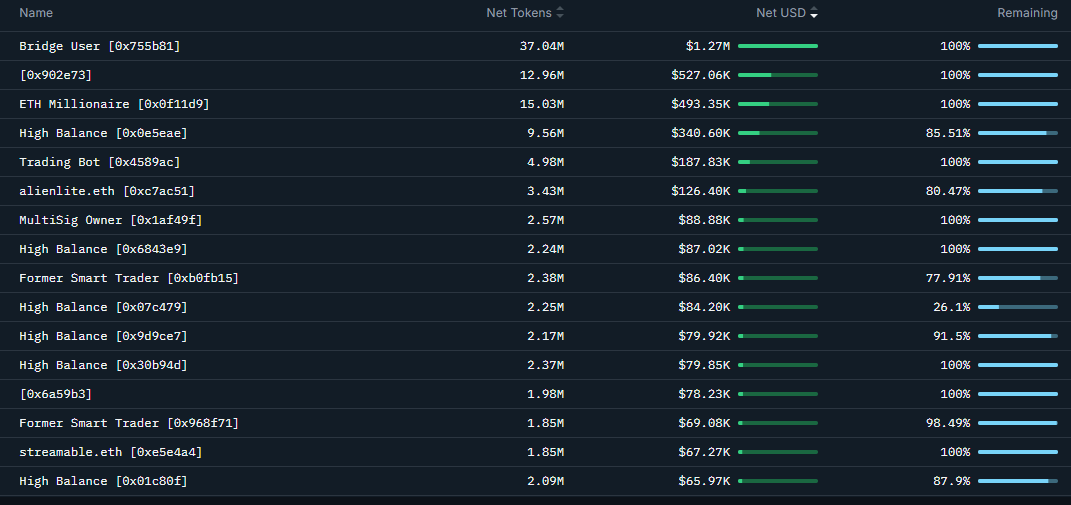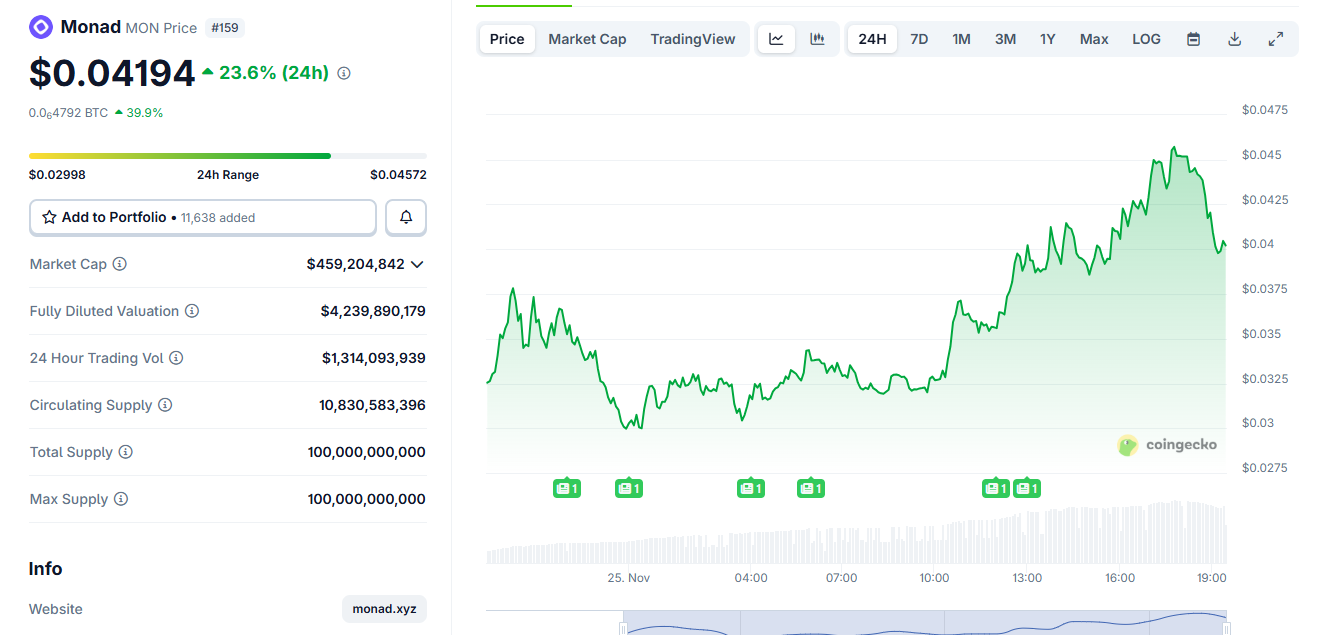Monad Is Still Rallying, But How Long Will It Last?
Monad’s MON token is defying 2025 airdrop trends with strong liquidity and record on-chain activity. Analysts now assess how long the rally can hold.
Monad’s MON token continues to rally after its long-anticipated mainnet launch, defying the steep post-airdrop declines that dominated 2025. The token has climbed more than 70% above its Coinbase sale price while the broader crypto market trades under heavy pressure.
Data from on-chain activity, exchange flows, and token distribution offer a clear explanation for the outperformance — and reveal how long the rally may realistically last.
Strong Day-One Performance Sets the Tone
Monad launched its public mainnet and MON token on November 24 with roughly 10–11% of its 100 billion supply unlocked.
The airdrop and public sale provided liquidity, while more than 50.6% of the supply (team, investors, treasury) remained locked through 2029.
 Large Monad Holders Are Still Not Selling Any MON Token. Source:
Nansen
Large Monad Holders Are Still Not Selling Any MON Token. Source:
Nansen
The launch attracted immediate attention. MON dipped about 15% in early trading, hitting $0.02 as airdrop sellers exited.
Buyers quickly absorbed the flow. Within 24 hours, MON traded near $0.03–0.035, and now sits around $0.04, more than 50–70% above its $0.025 public sale price.
This strength stands out in a market where Bitcoin has dropped below $90,000 and total crypto market capitalization has fallen by more than a trillion dollars since October.
 Monad Price Chart. Source:
CoinGecko
Monad Price Chart. Source:
CoinGecko
Airdrop and Token Sale Created a Stable Holder Base
Monad distributed roughly 4.73 billion MON in airdrops to 289,000 eligible accounts, with 3.33 billion ultimately claimed. The design targeted DeFi power-users, NFT traders, testnet contributors, and DAO participants rather than quest farmers.
The Coinbase token sale, which raised $269 million from about 85,820 participants, added a second cohort of committed holders. These buyers anchored around the $0.025 sale price and proved less eager to dump at launch.
Because insiders remain locked, early sellers were mostly airdrop recipients. This dynamic helped prevent the heavy cascades that crushed many 2025 airdrops.
my monad airdrop is worth $14,000?what the actual fuck hello wtf pic.twitter.com/zHkEdQQsIT
— Loshmi (@loshmi) November 25, 2025
Heavy Exchange Coverage Shielded MON From Volatility
MON was listed across major exchanges on day one, including Coinbase, Upbit, Bithumb, Kraken, Bybit, Bitget, Crypto.com, and MEXC. Derivatives opened on multiple venues, giving traders hedging options.
Deep order books absorbed airdrop selling. Market makers tightened spreads, and cross-venue liquidity reduced fragmentation. Traders could short, long, or hedge without flooding spot markets.
This broad coverage sharply contrasts with earlier L1 launches that relied on thin liquidity pools and fragmented markets, often triggering immediate 50–80% crashes.
Huge respect to @monad for not paying the Binance cartel listing fee.Probably not a coincidence that the price is going up.No serious project should waste millions of dollars for nothing (study Binance TGEs this cycle).gMonad
— Aylo (@alpha_pls) November 25, 2025
On-Chain Activity Surprised the Market
Monad’s first 24 hours delivered rare on-chain traction for a new L1. Nansen recorded:
- 3.7 million transactions
- 153,000 active addresses
- 18,000 contract deployments
These figures exceed what many blockchains achieve in their first year. They show early real usage from bots, arbitrageurs, developers, and liquidity programs.
.@Monad went live less than 24 hours agoIt already cleared:– 3.7M daily txns– 153K active addresses– 18K contract deploymentsThat’s higher day-one activity than most chains in their first year🧵 👇 pic.twitter.com/ggUwfOyjx7
— Nansen 🧭 (@nansen_ai) November 25, 2025
TVL reached ~$90 million, with Uniswap, Gearbox, Curve, and native dApps launching within hours. DEX volume crossed $70 million, driven by concentrated liquidity pools and farming incentives.
This early activity reinforced the perception that Monad launched as a functioning ecosystem, not as a speculative token awaiting future development.
Monad’s Rare Relative-Strength Play in a Weak Market
MON’s rally stands out because the rest of the market remains fragile. Bitcoin’s slide under $90,000 triggered retail outflows and pushed sentiment indicators into extreme fear.
Traders rotated into MON due to its relative strength. New tokens with credible metrics often attract momentum capital when major assets struggle.
This reflexive flow — strength attracting more capital — added fuel to the rally.
Arthur Hayes Goes All-In
Arthur Hayes weighed in with a sarcastic comment that captured the market mood.
Just what this bull market needs another low float , high FDV useless L1. But obvi I aped. It’s a bull market bitches!$MON to $10 pic.twitter.com/UMSDWWmp5a
— Arthur Hayes (@CryptoHayes) November 25, 2025
He highlighted MON’s low float and high FDV (fully diluted valuation). With only around 10% of supply circulating and FDV near $3–4 billion, MON fits the low-float pattern that dominates early-stage price action.
Yet Hayes admitted he bought anyway. His remark reflects how traders treat early L1 tokens: fundamentally risky, but attractive for short-term speculation.
How Long Can the Monad Rally Last?
The current data and patterns point to three time horizons that shape MON’s outlook.
Short Term: Rally Can Sustain
Monad has absorbed its largest early unlocks. Liquidity remains deep, and on-chain usage is rising. Incentive programs are launching, and trading flows remain strong.
Under these conditions, MON can maintain upward momentum for days or weeks.
Medium Term: Unlock Pressure Builds
Over the next several months, the circulating supply will rise as vesting tranches unlock. Even disciplined insider distribution adds structural sell pressure.
Activity may normalize after early incentives fade. If TVL flattens or starts slipping, the narrative could shift.
Longer Term: Fundamental Execution Matters
MON’s FDV places high expectations on the chain. Sustained growth in TVL, real applications, and developer traction will determine long-run resilience.
Without continued expansion, valuation compression becomes likely as supply expands.
In 2017 $ADA went from $3B → $30B in less than a month$MON just launched at $3BImagine the smell 💜 @monad pic.twitter.com/9LEg9WXNW9
— zac.eth 🧙🏻♂️♦️ (@zacxbt) November 24, 2025
Monad Token Outlook
Monad’s rally stems from a rare combination of strong distribution design, deep exchange liquidity, high early usage, and standout performance during a weak market.
This alignment makes MON one of the few 2025 airdrop tokens to defy the typical post-launch collapse.
The rally can continue in the short term as long as on-chain demand holds and liquidity remains supportive. However, the token’s high FDV and long vesting schedule introduce clear medium-term risks.
For now, MON remains a high-momentum asset driven by early fundamentals and speculative flows.
However, the durability of that momentum will depend on whether Monad converts its powerful first 48 hours into sustained ecosystem growth.
Read the article at BeInCryptoDisclaimer: The content of this article solely reflects the author's opinion and does not represent the platform in any capacity. This article is not intended to serve as a reference for making investment decisions.
You may also like
Bitcoin Updates Today: Texas Leads as First U.S. State to Establish Bitcoin Reserve, Creating a National Benchmark through BlackRock ETF
- Texas becomes first U.S. state to allocate $5M to Bitcoin via BlackRock’s IBIT ETF at $87,000/coin, using $10M from general revenue. - The move under Senate Bill 21 aims to diversify state treasuries, hedge inflation, and position Texas as a crypto policy leader. - While New Hampshire and Arizona explore similar reserves, Texas’s direct investment sets a precedent for institutional adoption. - Market analysis notes mixed timing, with Bitcoin near a potential local bottom but facing institutional selling
JPMorgan's Crackdown on Crypto Challenges U.S. Hopes for Digital Assets
- JPMorgan closed Jack Mallers' accounts at Strike, sparking debates over crypto "debanking" and regulatory pressures on banks . - Pro-crypto lawmakers accused the bank of enforcing "Operation Chokepoint 2.0," despite Trump's 2025 executive order banning such practices. - Industry leaders warned restricted banking access risks pushing crypto offshore, undermining U.S. competitiveness in digital assets. - JPMorgan's research warning about MSTR's potential $8.8B outflows intensified calls for a customer boyc
Trust Wallet Token (TWT) Price Forecast as Institutional Interest Rises
- Trust Wallet Token (TWT) gains institutional traction in 2025, driven by Binance CZ's endorsement and RWA partnerships expanding utility beyond DeFi. - Product innovations like FlexGas and Trust Premium reduce token velocity while boosting demand through cross-chain functionality and loyalty incentives. - Market dynamics show $11–12M daily trading volumes and fiat onboarding via Onramper, lowering barriers for institutional adoption in emerging markets. - TWT's transition from governance to operational u

Evaluating TWT’s Updated Tokenomics: Effects on the Market and Sustainable Value Amid an Evolving Crypto Environment
- TWT's tokenomics gains attention in late 2025 due to macroeconomic and tech shifts, not internal changes. - AI-driven retail innovation and Latin America's embedded finance growth drive market dynamics. - Investors prioritize utility-driven tokens like TWT, aligning with decentralized finance trends. - TWT's long-term value depends on adapting to tech trends and securing strategic partnerships.

